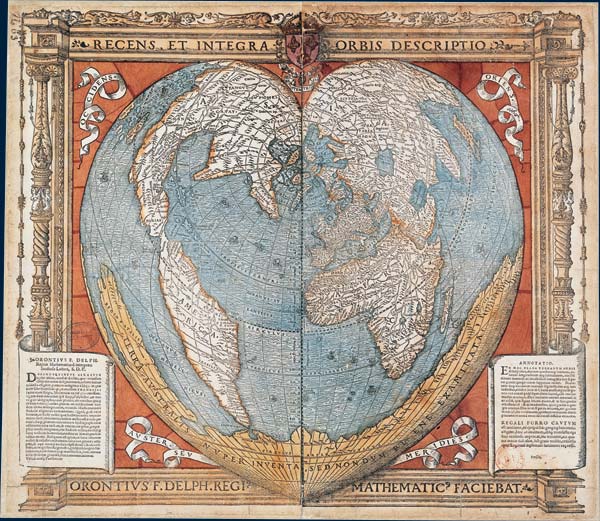<Back to Index>
- Cartographer Oronce Finé, 1494
- Playwright John Fletcher, 1579
- 12th Prime Minister of Australia Robert Gordon Menzies, 1894
PAGE SPONSOR


Oronce Fine (or Finé, In Latin, Orontius Finnaeus or Finaeus; Italian: Oronzio Fineo) (December 20, 1494 - August 8, 1555) was a French mathematician and cartographer.
Born in Briançon, the son and grandson of physicians, he was educated in Paris (Collège de Navarre), and obtained a degree in medicine in 1522. He was imprisoned in 1524, probably for practicing judicial astrology.
In 1531,
he was appointed to the chair of mathematics at the Collège
Royal (the present Collège
de France), founded by Francis I of
France, where he taught until his death. Although
primarily a populariser, Fine was one of the most prolific authors of
mathematical books of his age. He worked in a wide range of
mathematical fields, including practical geometry, arithmetic, optics,
gnomonics, astronomy, and instrumentalism. He gave
the value of pi to be (22 2/9)/7 in 1544.
Later, he gave 47/15 and, in De
rebus mathematicis (1556),
he gave 3 11/78. In 1542
Fine published De
mundi sphaera (On
the Heavenly Spheres), a popular astronomy textbook with woodcut illustrations. His
writing on astronomy included guides to the use of astronomical
equipment and methods (e.g. the ancient practice of determining longitude through
the coordinated observation of lunar eclipses from
two fixed points with enough distance between them to make the
phenomena appear at different times of the night.) He also described
more recent innovations, such as an instrument he called a méthéoroscope (an astrolabe modified by adding a compass). Explanatory
work
was complemented by direct contributions. His woodcut map of
France (1525) is one of the first of its kind. He constructed an ivory sundial in 1524, which still exists. Fine's
heart shaped (cordiform) map projection may be his most famous
illustration, and was frequently employed by other notable
cartographers, including Peter Apian and Gerardus
Mercator. Fine
attempted to reconcile discoveries in the New World with old medieval legends
and information (derived from Ptolemy)
regarding the Orient. Thus, on one of his two world maps, Nova Universi Orbis
Descriptio (1531),
the legend marked Asia covers
both North America and Asia,
which were represented as one landmass. He used the toponym "America" for South America,
and thus Marco Polo's Mangi, Tangut,
and Catay appear on the shores of the
present day Gulf of Mexico.
On the same map, Fine drew Terra Australis to
the south, including the legend "recently discovered but not yet
completely explored," by which Finé meant the discovery of Tierra del Fuego by Ferdinand
Magellan. Fine’s
cosmography was derived from the German mathematician and cosmographer, Johann Schoener. In
his study of Schöner‘s globes, Franz von Wieser, found that the
derivation of Fine’s mappemonde from them was “unmistakeable (unverkennbar)”. Lucien Gallois also noted the
undeniable “ressemblance
parfaite” between
Fine’s 1531 mappemonde and Schoener’s globe of 1533. As
Schoener’s globe of 1523, which also closely resembled Fine’s
mappemonde, was not identified until 1925 by Frederik (F.C.) Wieder,
Gallois was forced to argue that Fine, who said he had been working on
his mappemonde since 1521, had had direct or indirect personal
communication with Schoener or had drawn upon his 1515 Luculentissima
descriptio. Wieder’s
identification of Schoener’s map gores of 1523 strengthens Gallois’
case for Fine’s reliance upon Schoener. Fine died
in Paris at age 60. The lunar crater Orontius named after him, uses his
Latinized name. Jean Clouet is
said to have painted a portrait of Fine in 1530, when Fine was 36. With
the original painting lost, the rendering is now known only through
prints derived from the original image.